Influence of Long-Period Stacked Ordered Phases on Inductive Impedance of Mg-Gd-Y-Zn-Zr-Ag Alloys
Abstract
:1. Introduction
2. Materials and Methods
3. Results
3.1. Microstructure
3.2. EIS Test Results
3.3. Corrosion Morphology Observation
3.4. Equivalent Circuit and Fitting Results
4. Discussion
4.1. Relationship between Inductive Impedances and Capacitance
4.2. Influence of Intragranular LPSO on Capacitance
5. Conclusions
Author Contributions
Funding
Institutional Review Board Statement
Informed Consent Statement
Data Availability Statement
Conflicts of Interest
References
- Atrens, A.; Song, G.-L.; Cao, F.; Shi, Z.; Bowen, P.K. Advances in Mg corrosion and research suggestions. J. Magnes. Alloy. 2013, 1, 177–200. [Google Scholar] [CrossRef] [Green Version]
- Abbott, T.B. Magnesium: Industrial and research developments over the last 15 years. Corrosion 2014, 71, 120–127. [Google Scholar] [CrossRef] [PubMed]
- Atrens, A.; Song, G.-L.; Liu, M.; Shi, Z.; Cao, F.; Dargusch, M.S. Review of recent developments in the field of magnesium corrosion. Adv. Eng. Mater. 2015, 17, 400–453. [Google Scholar] [CrossRef]
- Zhou, X.; Yang, X.; Lu, X.; Zhang, J.; Yu, S.; Chen, X.; Lu, L. Effect of LPSO orientation on the compression behavior and workability of the Mg-5Gd-3Y–1Zn-0.5Zr alloy. Mater. Sci. Eng. A 2022, 857, 144115. [Google Scholar] [CrossRef]
- Yang, X.D.; Zhou, X.J.; Yu, S.L.; Zhang, J.; Lu, X.Z.; Chen, X.M.; Lu, L.W.; Huang, W.Y.; Liu, Y.R. Tensile behavior at various temperatures of the Mg-Gd-Y-Zn-Zr alloys with different initial morphologies of LPSO phases prior to extrusion. Mater. Sci. Eng. A 2022, 851, 143634. [Google Scholar] [CrossRef]
- Lu, X.; Zou, X.; Zhou, X.; Zhang, J.; Chen, X.; Zhang, J.; Lai, C.; Chan, L.; Hu, T. Tunable mechanical and degradation properties of biodegradable Mg–Y–Zn alloys via Zn content regulation. J. Mater. Res. Technol. 2022, 20, 3173–3184. [Google Scholar] [CrossRef]
- Liu, L.; Zhou, X.J.; Yu, S.L.; Zhang, J.; Lu, X.Z.; Shu, X.; Su, Z.J. Effects of heat treatment on mechanical properties of an extruded Mg-4.3Gd-3.2Y-1.2Zn-0.5Zr alloy and establishment of its Hall-Petch relation. J. Magnes. Alloy. 2022, 10, 501–512. [Google Scholar] [CrossRef]
- Nie, Y.; Dai, J.; Li, X.; Zhang, X. Recent developments on corrosion behaviors of Mg alloys with stacking fault or long period stacking ordered structures. J. Magnes. Alloy. 2021, 9, 1123–1146. [Google Scholar] [CrossRef]
- Srinivasan, A.; Huang, Y.; Mendis, C.L.; Blawert, C.; Kainer, K.U.; Hort, N. Investigations on microstructures, mechanical and corrosion properties of Mg–Gd–Zn alloys. Mater. Sci. Eng. A 2014, 595, 224–234. [Google Scholar] [CrossRef]
- Pérez, P.; Cabeza, S.; Garcés, G.; Adeva, P. Influence of long period stacking ordered phase arrangements on the corrosion behaviour of extruded Mg97Y2Zn1 alloy. Corros. Sci. 2016, 107, 107–112. [Google Scholar] [CrossRef]
- Zhang, J.; Xu, M.; Teng, X.; Zuo, M. Effect of Gd addition on microstructure and corrosion behaviors of Mg–Zn–Y alloy. J. Magnes. Alloy. 2016, 4, 319–325. [Google Scholar] [CrossRef] [Green Version]
- Song, Y.; Shan, D.; Chen, R.; Han, E.-H. Effect of second phases on the corrosion behaviour of wrought Mg–Zn–Y–Zr alloy. Corros. Sci. 2010, 52, 1830–1837. [Google Scholar] [CrossRef]
- Raja, V.S.; Padekar, B.S. Role of chlorides on pitting and hydrogen embrittlement of Mg–Mn wrought alloy. Corros. Sci. 2013, 75, 176–183. [Google Scholar] [CrossRef]
- Song, Y.; Shan, D.; Chen, R.; Han, E.-H. Pitting corrosion of a rare earth Mg alloy GW93. J. Mater. Res. Technol. 2017, 33, 954–960. [Google Scholar] [CrossRef]
- Baril, G.; Galicia, G.; Deslouis, C.; Pébère, N.; Tribollet, B.; Vivier, V. An impedance investigation of the mechanism of pure magnesium corrosion in sodium sulfate solutions. J. Electrochem. Soc. 2007, 154, C108–C113. [Google Scholar] [CrossRef] [Green Version]
- Galicia, G.; Pébère, N.; Tribollet, B.; Vivier, V. Local and global electrochemical impedances applied to the corrosion behaviour of an AZ91 magnesium alloy. Corros. Sci. 2009, 51, 1789–1794. [Google Scholar] [CrossRef] [Green Version]
- Gomes, M.P.; Costa, I.; Pébère, N.; Rossi, J.L.; Tribollet, B.; Vivier, V. On the corrosion mechanism of Mg investigated by electrochemical impedance spectroscopy. Electrochim. Acta 2019, 306, 61–70. [Google Scholar] [CrossRef] [Green Version]
- Bland, L.G.; King, A.D.; Birbilis, N.; Scully, J.R. Assessing the corrosion of commercially pure magnesium and commercial AZ31B by electrochemical impedance, mass-loss, hydrogen collection, and inductively coupled plasma optical emission spectrometry solution analysis. Corrosion 2014, 71, 128–145. [Google Scholar] [CrossRef]
- Liu, J.; Song, Y.; Shan, D.; Han, E.-H. Different microgalvanic corrosion behavior of cast and extruded EW75 Mg alloys. J. Electrochem. Soc. 2016, 163, C856–C863. [Google Scholar] [CrossRef] [Green Version]
- Xu, S.-Y.; Liu, C.-M.; Wan, Y.-C.; Zeng, G.; Gao, Y.-H.; Jiang, S.N. Corrosion behaviour of Mg-Gd-Y-Zn-Ag alloy components with different sizes after cooling. Trans. Nonferr. Metal. Soc. 2021, 31, 1291–1302. [Google Scholar] [CrossRef]
- Mingo, B.; Arrabal, R.; Mohedano, M.; Pardo, A.; Matykina, E.; Rivas, A. Enhanced corrosion resistance of AZ91 alloy produced by semisolid metal processing. J. Electrochem. Soc. 2015, 162, C180–C188. [Google Scholar] [CrossRef]
- Song, G.-L.; Atrens, A.; John, D.S.; Wu, X.; Nairn, J. The anodic dissolution of magnesium in chloride and sulphate solutions. Corros. Sci. 1997, 39, 1981–2004. [Google Scholar] [CrossRef]
- Song, G.-L.; Atrens, A.; Stjohn, D.; Nairn, J.; Li, Y. The electrochemical corrosion of pure magnesium in 1 N NaCl. Corros. Sci. 1997, 39, 855–875. [Google Scholar] [CrossRef]
- Song, G.-L. Effect of tin modification on corrosion of AM70 magnesium alloy. Corros. Sci. 2009, 51, 2063–2070. [Google Scholar] [CrossRef]
- Shi, Z.; Cao, F.; Song, G.-L.; Liu, M.; Atrens, A. Corrosion behaviour in salt spray and in 3.5% NaCl solution saturated with Mg(OH)2 of as-cast and solution heat-treated binary Mg–RE alloys: RE = Ce, La, Nd, Y, Gd. Corros. Sci. 2013, 76, 98–118. [Google Scholar] [CrossRef]
- Medhashree, H.; Shetty, A.N. Electrochemical corrosion study of Mg–Al–Zn–Mn alloy in aqueous ethylene glycol containing chloride ions. J. Mater. Res. Technol. 2017, 6, 40–49. [Google Scholar] [CrossRef] [Green Version]
- Acharya, M.G.; Shetty, A.N. The corrosion behavior of AZ31 alloy in chloride and sulfate media–A comparative study through electrochemical investigations. J. Magnes. Alloy. 2019, 7, 98–112. [Google Scholar] [CrossRef]
- King, A.D.; Birbilis, N.; Scully, J.R. Accurate electrochemical measurement of magnesium corrosion rates; a combined impedance, mass-loss and hydrogen collection study. Electrochim. Acta 2014, 121, 394–406. [Google Scholar] [CrossRef]
- Curioni, M.; Salamone, L.; Scenini, F.; Santamaria, M.; Natale, M.D. A mathematical description accounting for the superfluous hydrogen evolution and the inductive behaviour observed during electrochemical measurements on magnesium. Electrochim. Acta 2018, 274, 343–352. [Google Scholar] [CrossRef]
- Chen, X.; Zou, Q.; Le, Q.; Hou, J.; Guo, R.; Wang, H.; Hu, C.; Bao, L.; Wang, T.; Zhao, D.; et al. The quasicrystal of Mg–Zn–Y on discharge and electrochemical behaviors as the anode for Mg-air battery. J. Power Sources 2020, 451, 227807. [Google Scholar] [CrossRef]
- Zhang, T.; Meng, G.; Shao, Y.; Cui, Z.; Wang, F. Corrosion of hot extrusion AZ91 magnesium alloy. Part II: Effect of rare earth element neodymium (Nd) on the corrosion behavior of extruded alloy. Corros. Sci. 2011, 53, 2934–2942. [Google Scholar] [CrossRef]
- Cao, F.; Shi, Z.; Song, G.-L.; Liu, M.; Dargusch, M.S.; Atrens, A. Influence of casting porosity on the corrosion behaviour of Mg0.1Si. Corros. Sci. 2015, 94, 255–269. [Google Scholar] [CrossRef]
- Xu, H.; Zhang, X.; Zhang, K.; Shi, Y.; Ren, J. Effect of extrusion on corrosion behavior and corrosion mechanism of Mg-Y alloy. J. Rare Earth 2016, 34, 315–327. [Google Scholar] [CrossRef]
- Li, J.; Zhang, B.; Wei, Q.; Wang, N.; Hou, B. Electrochemical behavior of Mg-Al-Zn-In alloy as anode materials in 3.5wt.% NaCl solution. Electrochim. Acta 2017, 238, 156–167. [Google Scholar] [CrossRef]
- Li, B.; Sun, J.; Xu, B.; Wu, G. Corrosion behavior of Mg-5.7Gd-1.9Ag Mg alloy sheet. J. Alloys Compd. 2022, 915, 165241. [Google Scholar] [CrossRef]
- Zhang, X.; Ba, Z.; Wang, Q.; Wu, Y.; Wang, Z.; Wang, Q. Uniform corrosion behavior of GZ51K alloy with long period stacking ordered structure for biomedical application. Corros. Sci. 2014, 88, 1–5. [Google Scholar] [CrossRef]
- Peng, Q.; Guo, J.; Fu, H.; Cai, X.; Wang, Y.; Liu, B.; Xu, Z. Degradation behavior of Mg-based biomaterials containing different long-period stacking ordered phases. Sci. Rep. 2014, 4, 1–8. [Google Scholar] [CrossRef] [Green Version]
- Zhang, X.; Wang, Q.; Chen, F.; Wu, Y.; Wang, Z.; Wang, Q. Relation between LPSO structure and biocorrosion behavior of biodegradable GZ51K alloy. Mater. Lett. 2015, 138, 212–215. [Google Scholar] [CrossRef]
- Bi, G.; Jiang, J.; Zhang, F.; Fang, D.; Li, Y.; Ma, Y.; Hao, Y. Microstructure evolution and corrosion properties of Mg-Dy-Zn alloy during cooling after solution treatment. J. Rare Earth 2016, 34, 931–937. [Google Scholar] [CrossRef]
- Zhang, X.; Ba, Z.; Wang, Z.; Xue, Y. Microstructures and corrosion behavior of biodegradable Mg–6Gd–xZn–0.4Zr alloys with and without long period stacking ordered structure. Corros. Sci. 2016, 105, 68–77. [Google Scholar] [CrossRef]
- Wang, J.; Jiang, W.; Ma, Y.; Li, Y.; Huang, S. Substantial corrosion resistance improvement in heat-treated Mg–Gd–Zn alloys with a long period stacking ordered structure. Mater. Chem. Phys. 2018, 203, 352–361. [Google Scholar] [CrossRef]
- Xu, S.; Jiang, S.; Chen, Z.; Liu, C. Influence of corrosion morphology on inductive impedance of Mg-Gd-Y-Zn-Zr-Ag alloy. J. Mater. Eng. Perform. 2021, 30, 4126–4137. [Google Scholar] [CrossRef]
- Zheng, L.; Liu, C.; Wan, Y.; Yang, P.; Shu, X. Microstructures and mechanical properties of Mg–10Gd–6Y–2Zn–0.6Zr(wt.%) alloy. J. Alloy Compd. 2011, 509, 8832–8839. [Google Scholar] [CrossRef]
- Xu, C.; Zheng, M.Y.; Wu, K.; Wang, E.D.; Fan, G.H.; Xu, S.W.; Kamado, S.; Liu, X.D.; Wang, G.J.; Lv, X.Y. Effect of cooling rate on the microstructure evolution and mechanical properties of homogenized Mg–Gd–Y–Zn–Zr alloy. Mater. Sci. Eng. A 2013, 559, 364–370. [Google Scholar] [CrossRef]
- Klotz, D. Negative capacitance or inductive loop?–A general assessment of a common low frequency impedance feature. Electrochem. Commun. 2019, 98, 58–62. [Google Scholar] [CrossRef]
- Wang, H.X.; Song, Y.W.; Yu, J.; Shan, D.Y.; Han, H. Characterization of filiform corrosion of Mg-3Zn Mg Alloy. J. Electrochem. Soc. 2017, 164, C574–C580. [Google Scholar] [CrossRef]
- Cao, F.; Shi, Z.; Hofstetter, J.; Uggowitzer, P.J.; Song, G.-L.; Liu, M.; Atrens, A. Corrosion of ultra-high-purity Mg in 3.5% NaCl solution saturated with Mg(OH)2. Corros. Sci. 2013, 75, 78–99. [Google Scholar] [CrossRef]
- Cao, F.; Shi, Z.; Song, G.-L.; Liu, M.; Atrens, A. Corrosion behaviour in salt spray and in 3.5% NaCl solution saturated with Mg(OH)2 of as-cast and solution heat-treated binary Mg–X alloys: X=Mn, Sn, Ca, Zn, Al, Zr, Si, Sr. Corros. Sci. 2013, 76, 60–97. [Google Scholar] [CrossRef]
- Cao, F.; Song, G.-L.; Atrens, A. Corrosion and passivation of magnesium alloys. Corros. Sci. 2016, 111, 835–845. [Google Scholar] [CrossRef] [Green Version]
- Wang, H.; Li, Y.; Wang, F. Influence of cerium on passivity behavior of wrought AZ91 alloy. Electrochim. Acta 2008, 54, 706–713. [Google Scholar] [CrossRef]
- Nordlien, J.H.; Ono, S.; Masuko, N.; Nisancioglu, K. A TEM investigation of naturally formed oxide films on pure magnesium. Corros. Sci. 1997, 39, 1397–1414. [Google Scholar] [CrossRef]
- Taheri, M.; Phillips, R.C.; Kish, J.R.; Botton, G.A. Analysis of the surface film formed on Mg by exposure to water using a FIB cross-section and STEM–EDS. Corros. Sci. 2012, 59, 222–228. [Google Scholar] [CrossRef]
- Song, Y.; Han, E.-H.; Dong, K.; Shan, D.; Yim, C.D.; You, B.S. Study of the corrosion product films formed on the surface of Mg–xZn alloys in NaCl solution. Corros. Sci. 2014, 88, 215–225. [Google Scholar] [CrossRef]
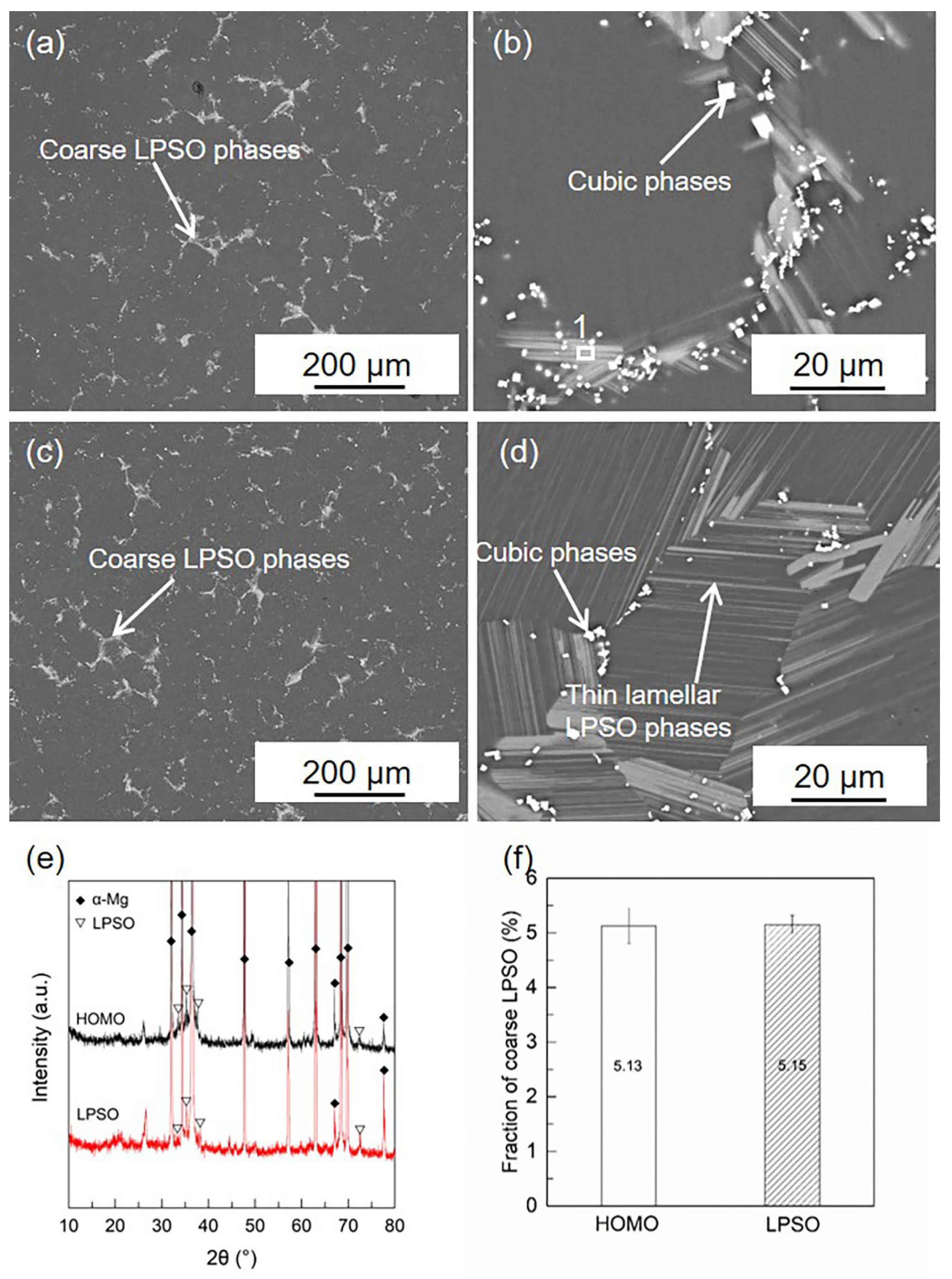
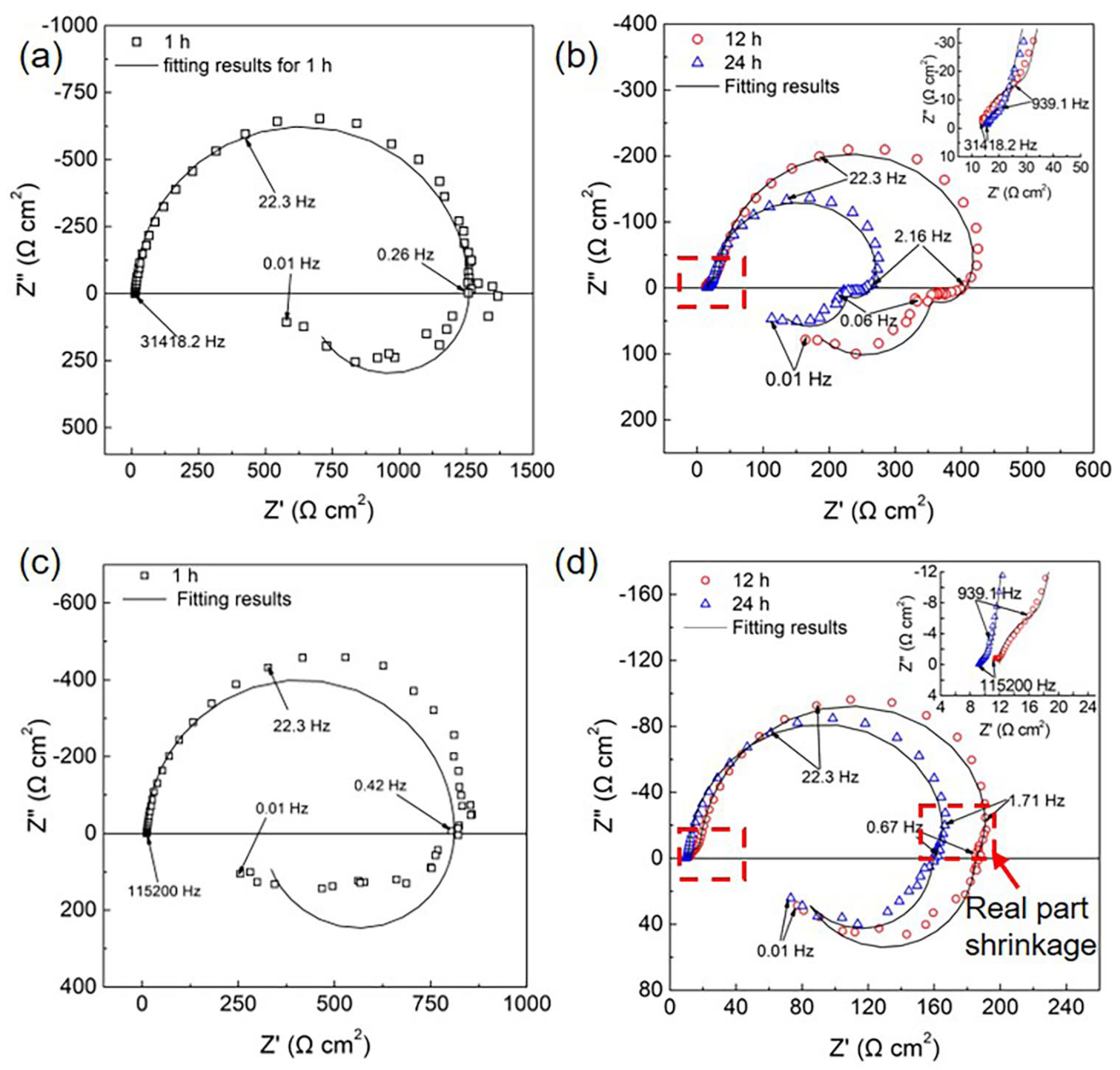
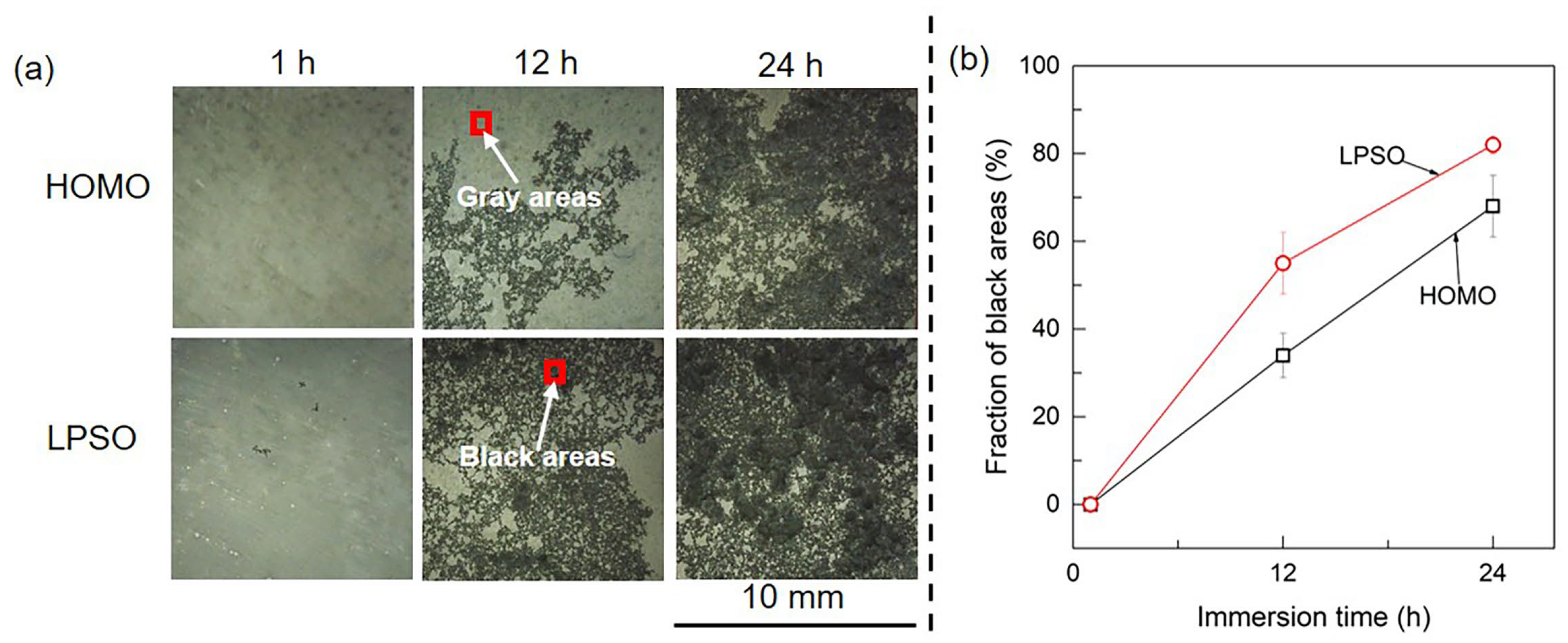
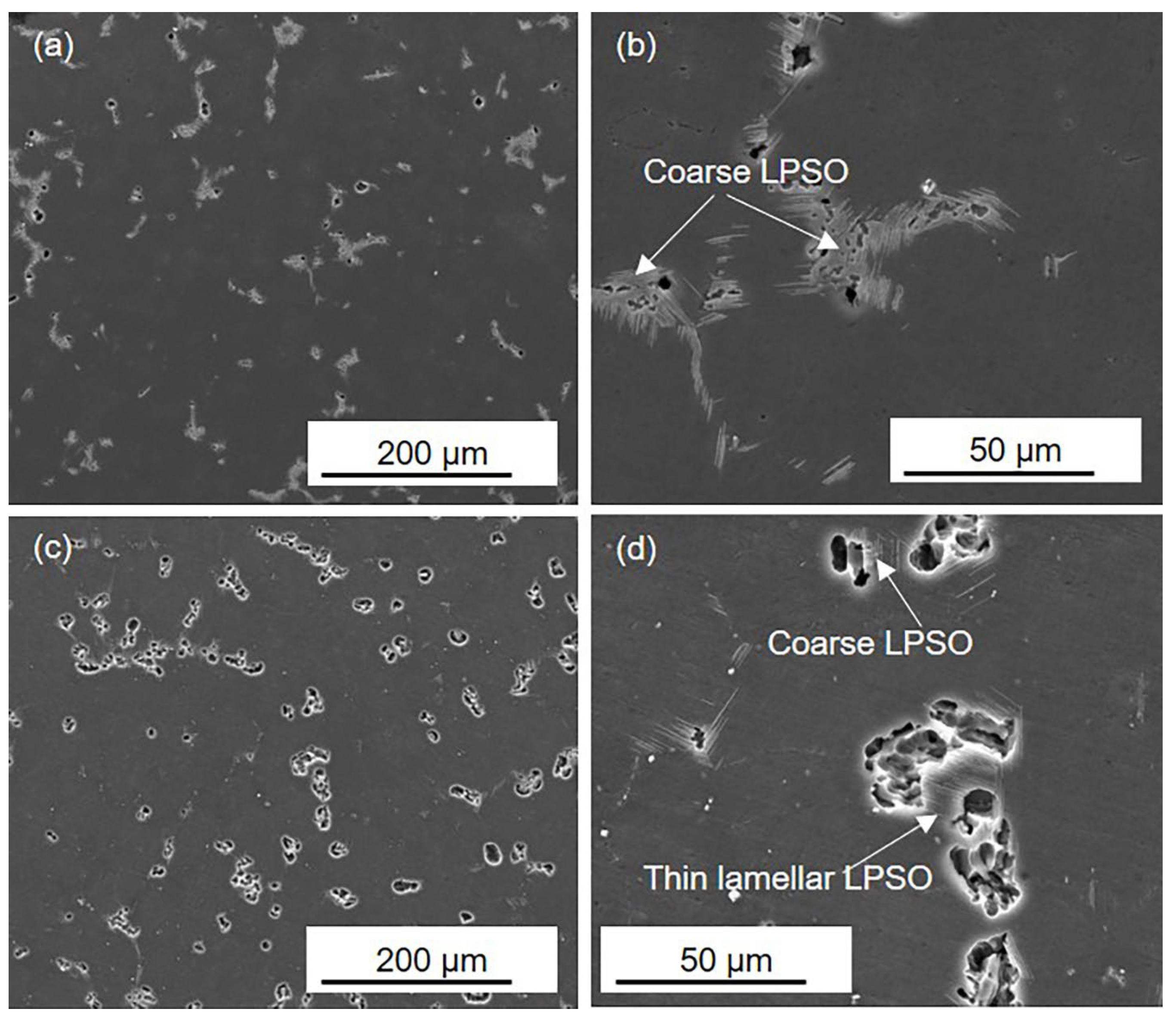

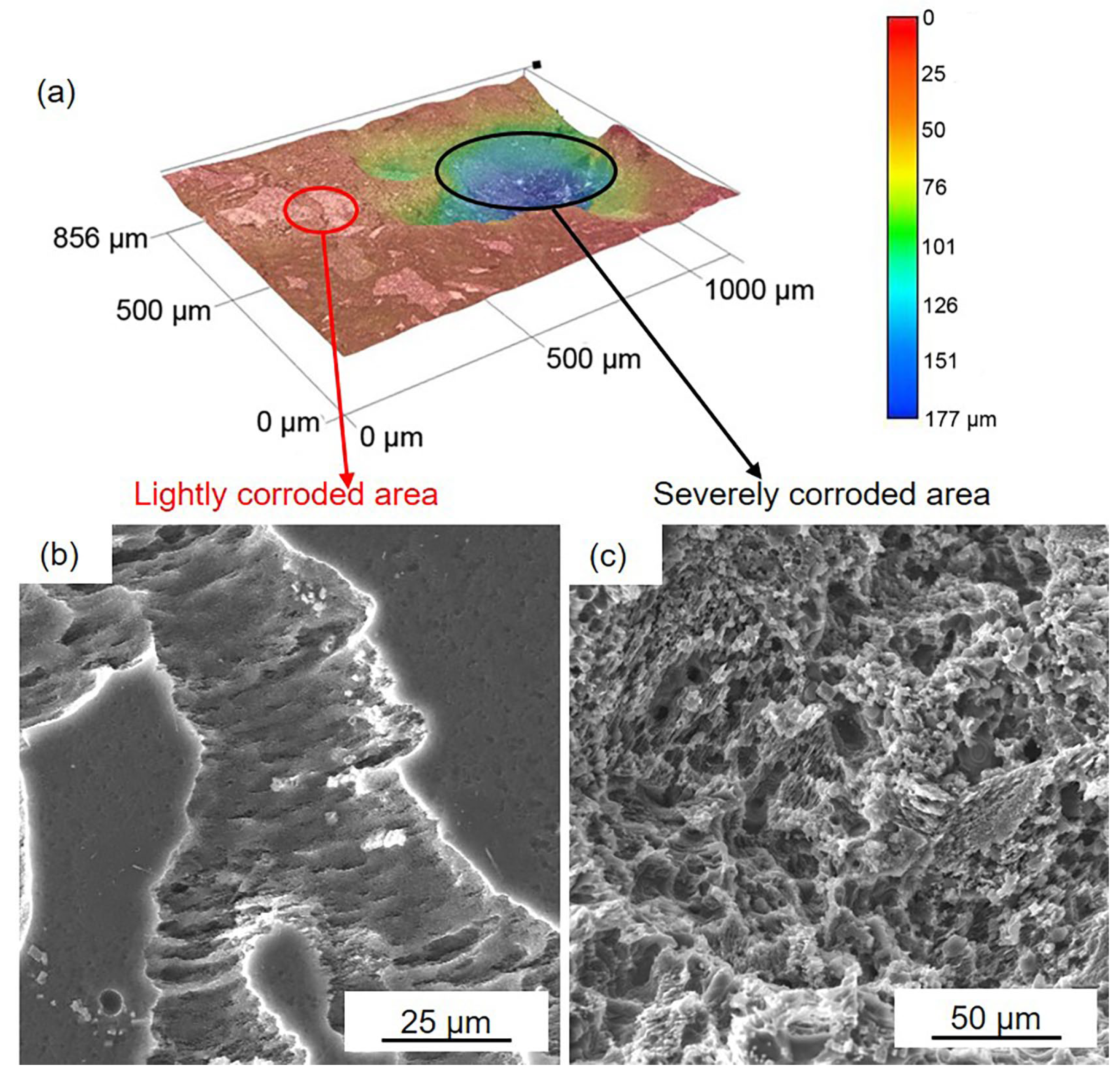

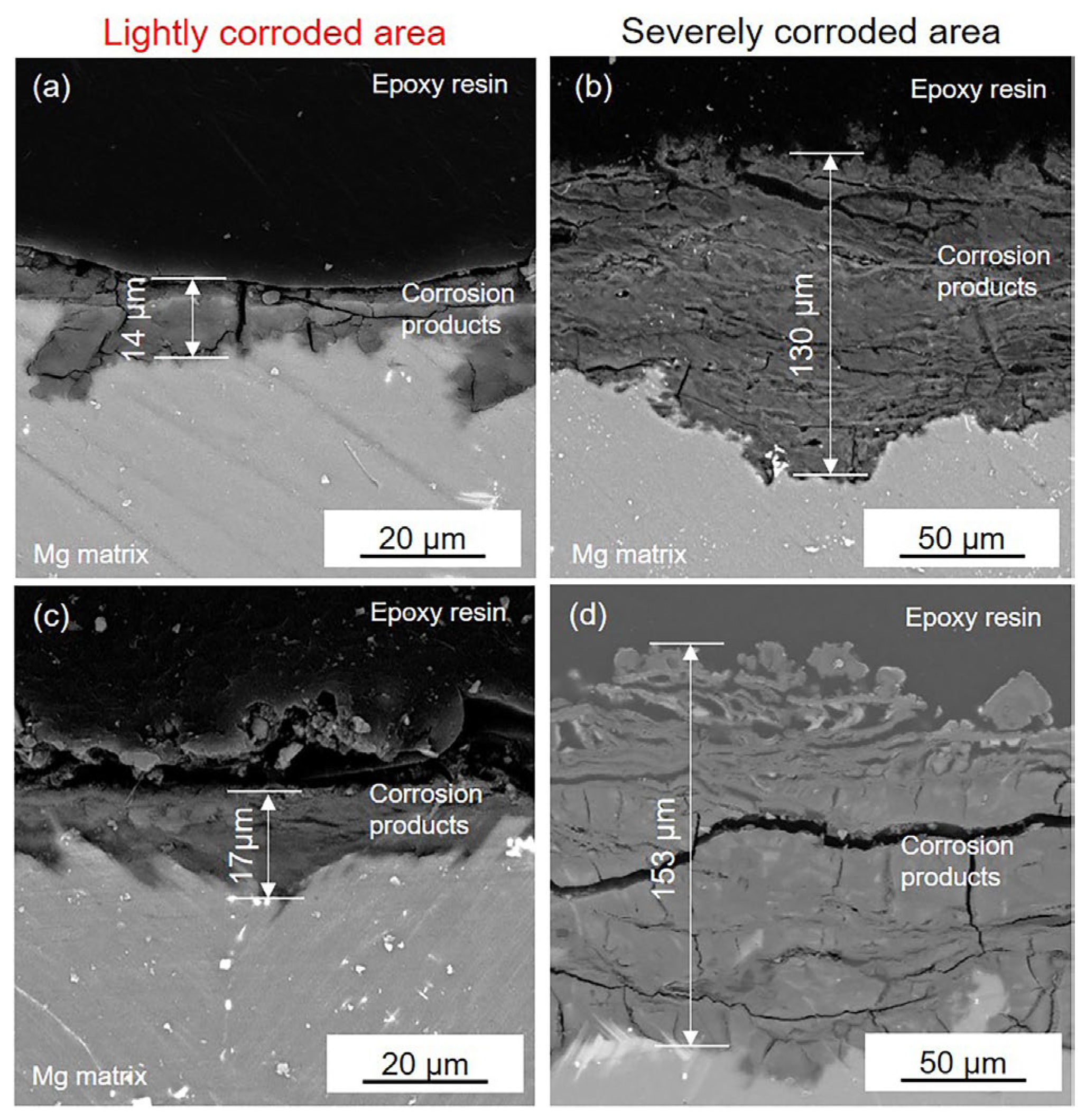
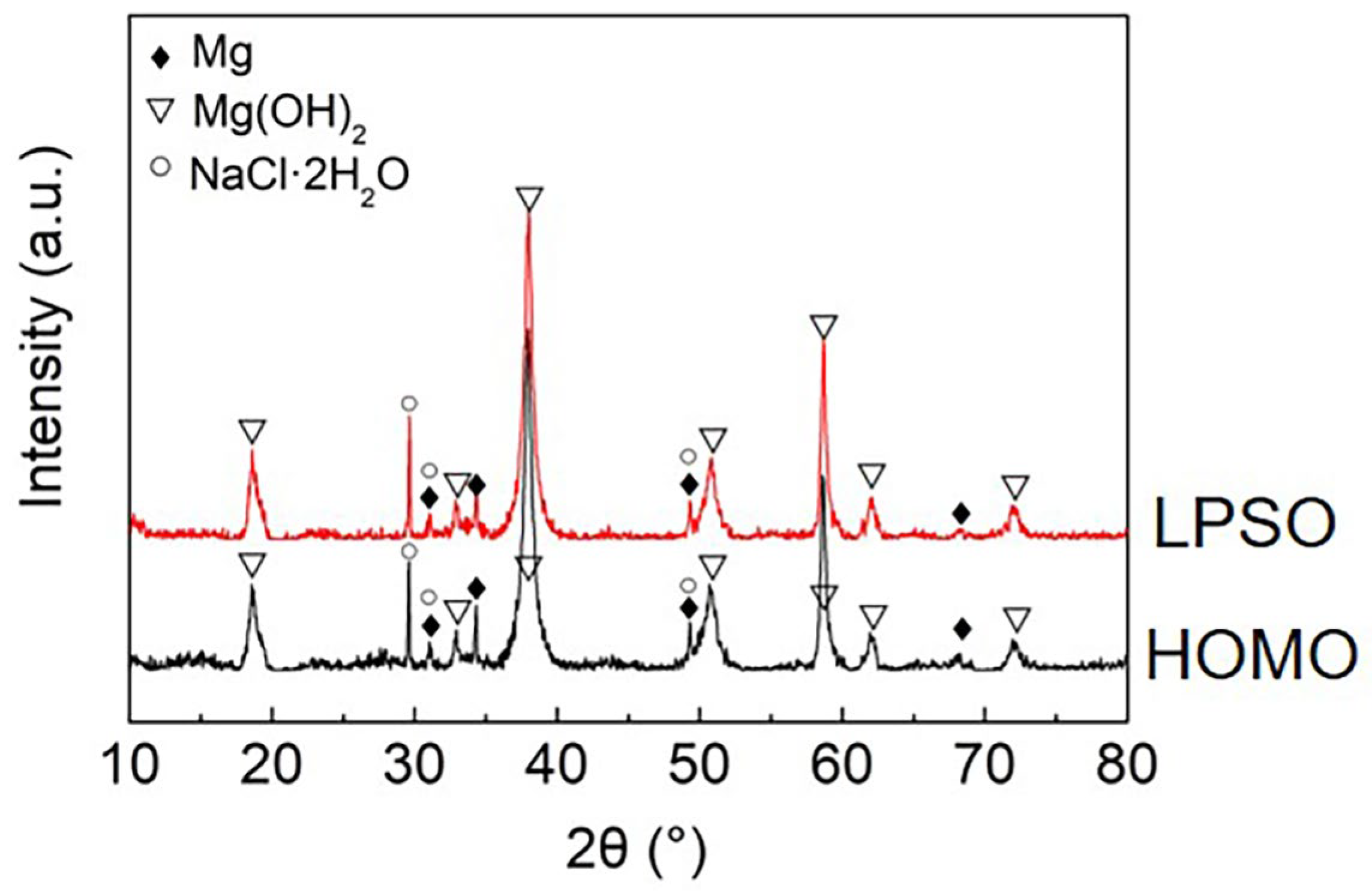


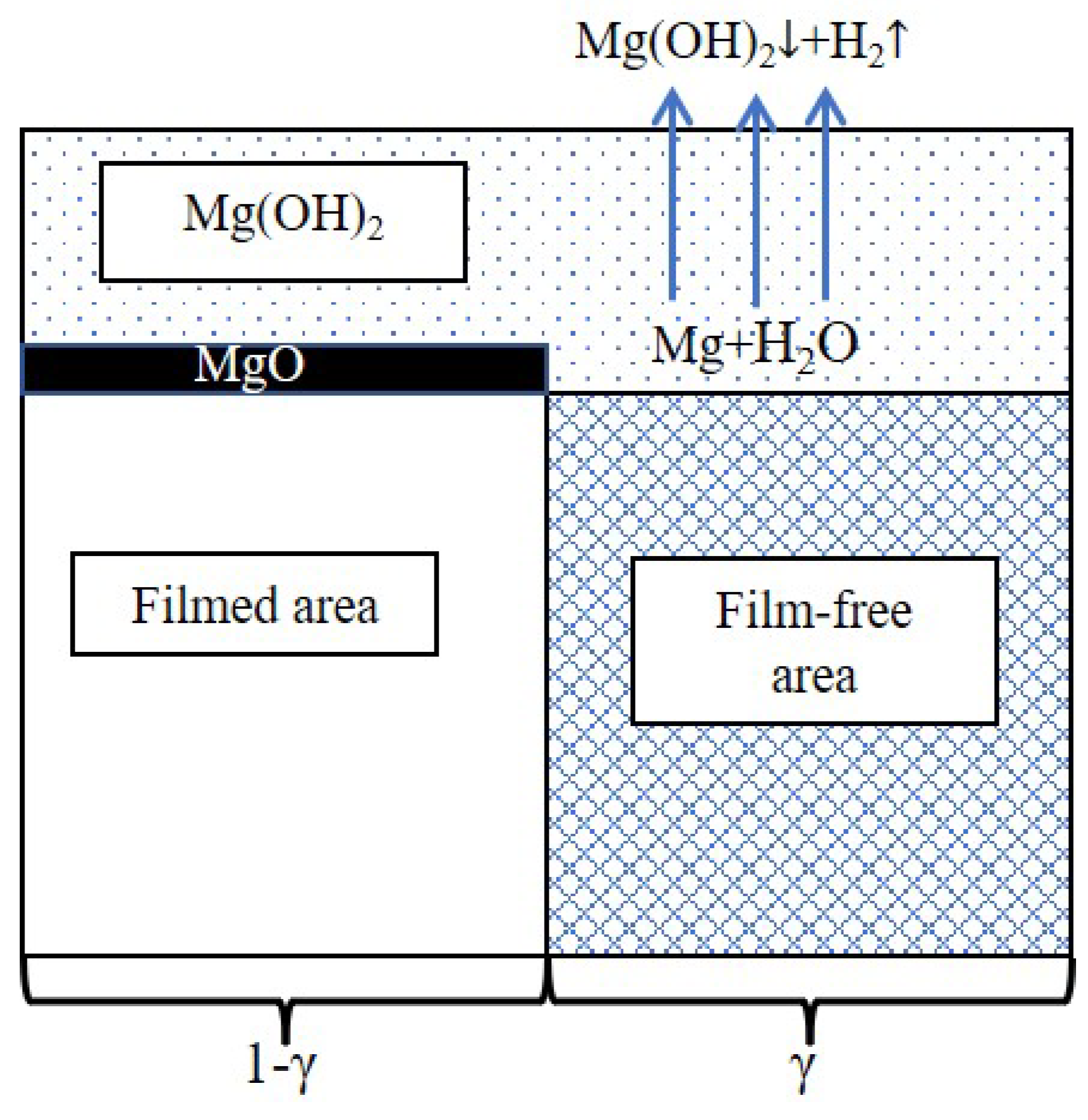
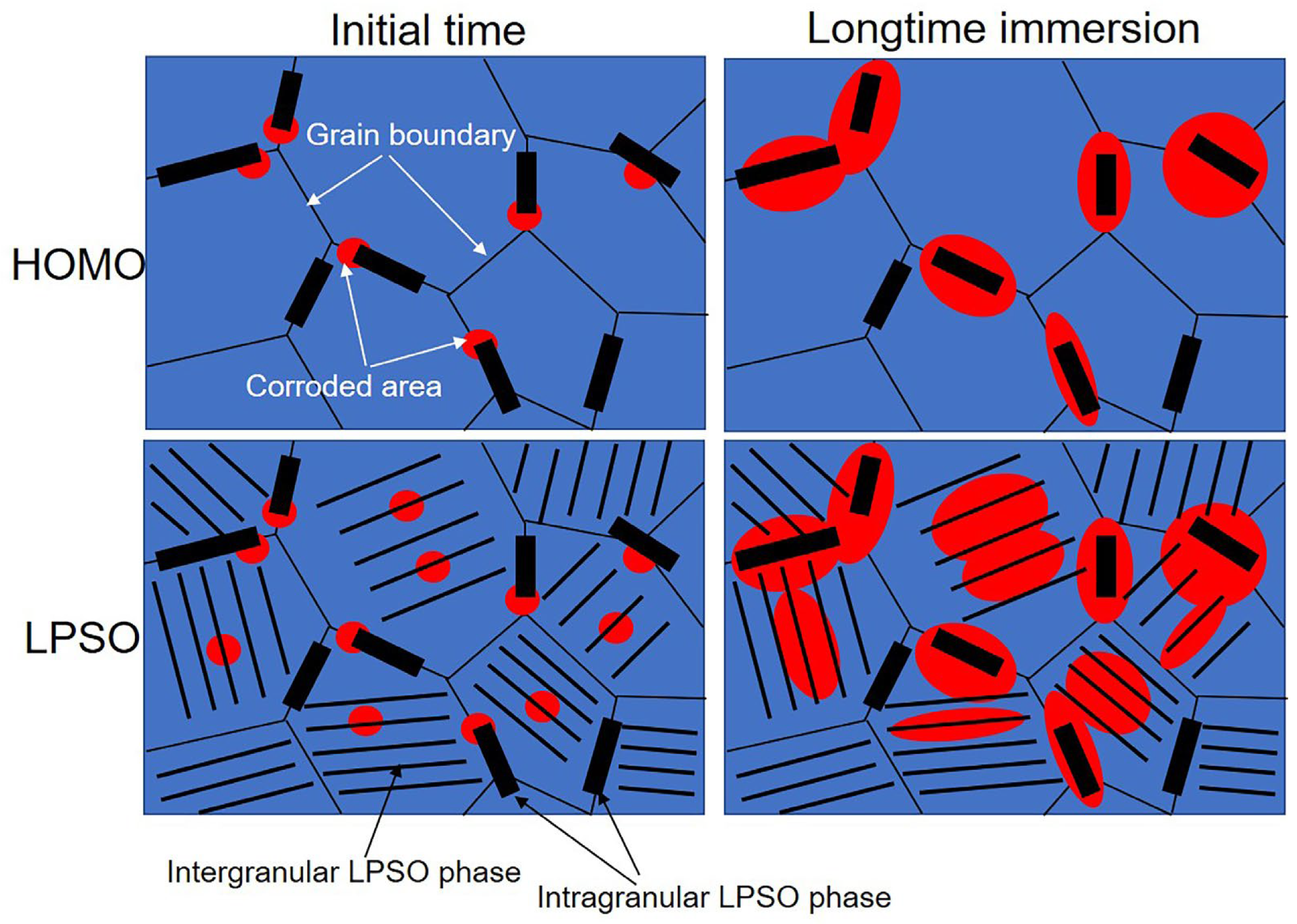
| HOMO-1 h | HOMO-12 h | HOMO-24 h | LPSO-1 h | LPSO-12 h | LPSO-24 h | |
|---|---|---|---|---|---|---|
| (Ω cm2) | 13 | 14 | 15 | 12 | 12 | 10 |
| (F cm−2) | - | 5.06 × 10−6 | 9.30 × 10−6 | - | 1.43 × 10−5 | 2.66 × 10−5 |
| (Ω cm2) | - | 29 | 14 | - | 13 | 6 |
| (F cm−2) | 8.37 × 10−6 | 1.72 × 10−5 | 2.92 × 10−5 | 9.69 × 10−6 | 3.52 × 10−5 | 3.83 × 10−5 |
| (Ω cm2) | 1247 | 395 | 254 | 800 | 179 | 159 |
| (H cm2) | 12,227 | 167 | 108 | 4071 | 78 | 99 |
| (Ω cm2) | 1357 | 1717 | 1016 | 494 | 1716 | 1576 |
| (H cm2) | - | 4270 | 3153 | - | 1287 | 1626 |
| (Ω cm2) | - | 232 | 177 | - | 103 | 113 |
| χ2 | 0.018 | 0.011 | 0.011 | 0.033 | 0.007 | 0.011 |
| Cf (F cm−2) | C (F cm−2) | ||
|---|---|---|---|
| HOMO-12 h | 5.06 × 10−6 | 1.72 × 10−5 | 2.23 × 10−5 |
| HOMO-24 h | 9.30 × 10−6 | 2.92 × 10−5 | 3.85 × 10−5 |
| LPSO-12 h | 1.43 × 10−5 | 3.52 × 10−5 | 4.95 × 10−5 |
| LPSO-24 h | 2.66 × 10−5 | 3.83 × 10−5 | 6.49 × 10−5 |
Disclaimer/Publisher’s Note: The statements, opinions and data contained in all publications are solely those of the individual author(s) and contributor(s) and not of MDPI and/or the editor(s). MDPI and/or the editor(s) disclaim responsibility for any injury to people or property resulting from any ideas, methods, instructions or products referred to in the content. |
© 2023 by the authors. Licensee MDPI, Basel, Switzerland. This article is an open access article distributed under the terms and conditions of the Creative Commons Attribution (CC BY) license (https://creativecommons.org/licenses/by/4.0/).
Share and Cite
Xu, S.; Liu, C.; Gao, Y.; Jiang, S.; Wan, Y.; Chen, Z. Influence of Long-Period Stacked Ordered Phases on Inductive Impedance of Mg-Gd-Y-Zn-Zr-Ag Alloys. Materials 2023, 16, 640. https://doi.org/10.3390/ma16020640
Xu S, Liu C, Gao Y, Jiang S, Wan Y, Chen Z. Influence of Long-Period Stacked Ordered Phases on Inductive Impedance of Mg-Gd-Y-Zn-Zr-Ag Alloys. Materials. 2023; 16(2):640. https://doi.org/10.3390/ma16020640
Chicago/Turabian StyleXu, Shiyuan, Chuming Liu, Yonghao Gao, Shunong Jiang, Yingchun Wan, and Zhiyong Chen. 2023. "Influence of Long-Period Stacked Ordered Phases on Inductive Impedance of Mg-Gd-Y-Zn-Zr-Ag Alloys" Materials 16, no. 2: 640. https://doi.org/10.3390/ma16020640
APA StyleXu, S., Liu, C., Gao, Y., Jiang, S., Wan, Y., & Chen, Z. (2023). Influence of Long-Period Stacked Ordered Phases on Inductive Impedance of Mg-Gd-Y-Zn-Zr-Ag Alloys. Materials, 16(2), 640. https://doi.org/10.3390/ma16020640







